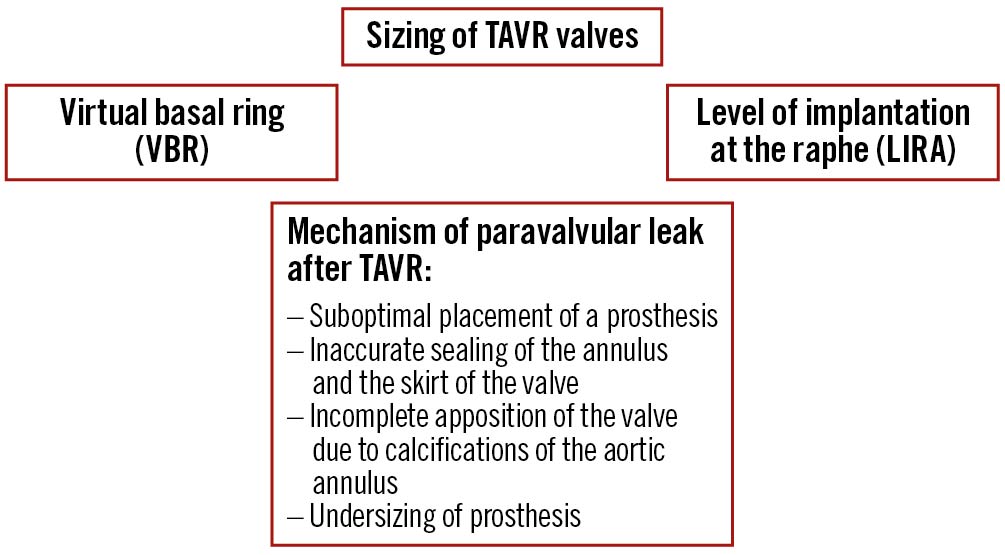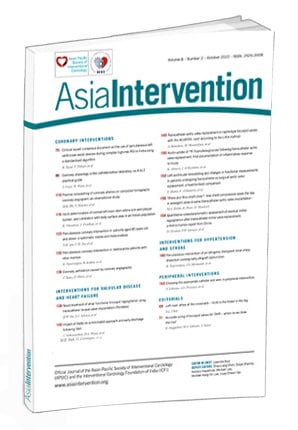Bicuspid aortic valve (BAV) anatomy poses challenges to operators in the preprocedural, procedural, and post-procedural decision making during transcatheter aortic valve replacement (TAVR). Randomised clinical trials have generally excluded BAV patients so more data are needed to achieve optimal results with TAVR in this context1. The orifice of the aortic valve in BAV is elliptical/supra-annular in geometry and is smaller than the annulus in size. Calcification of the aortic root and the slit-like elliptical orifices associated with BAV can impose greater aortic angulation and make delineation of the anatomical geometry of the heart valve and the aortic root difficult, thereby posing a risk of patient-prosthesis mismatch or paravalvular leak (PVL)2. All the aforementioned risk factors raise the important concept of sizing the TAVR valve for BAV patients based on the supra-annular rather than the annular plane3. A simplified outline of the mechanism of PVL after TAVR and the methods used to size transcatheter heart valves (THV) is provided in Figure 1.

Figure 1. Methods for sizing TAVR valves, and the common mechanism of paravalvular leak in the setting of TAVR. TAVR: transcatheter aortic valve replacement
In this issue of AsiaIntervention, a cohort study by Beneduce et al4 proposed a novel method of sizing TAVR valves with a focus on raphe-type BAV preconfirmed by multimodal computed tomography (CT) scan. The authors reported a highly accurate way of sizing THV by measuring the size of the valve at the supra-annular level of implantation at the raphe (LIRA) plane rather than at the annular plane. This proposed method aims to decrease the amount of PVL associated with BAV TAVR. Beneduce et al focused mainly on the new self-expanding TAVR prosthesis, the ACURATE neo2 in their study. Iannopollo et al also previously described the supra-annular sizing method in a larger cohort of patients, where they achieved ideal outcomes5. Supra-annular sizing for THV using the LIRA method has also been reported in BAV with aortic regurgitation and aortic stenosis67.
The study by Beneduce et al followed preoperative and intraoperative requisites for THV in BAV with raphe and demonstrated that the LIRA method is better for accurate sizing of THV, with the authors reporting 100% efficacy in preventing moderate to severe PVL in BAV. THV size is smaller using the LIRA method than using the virtual basal ring (VBR) plane. However, the sample size reported in the study was small and there was no comparison group to enable definitive conclusions. Furthermore, the follow-up period was only 30 days. THV sizing using the LIRA method in BAV resulted in more stable anchoring and sealing of the valve with an acceptable mean gradient of less than 20 mmHg.
There are several important questions that we need further data to answer in the future. Are we creating a degree of patient-prosthesis mismatch which needs a longer follow-up period to be detectable?8. Can we achieve the same results of eliminating PVL in BAV patients by routine post-deployment ballooning? Does the outcome in BAV sizing vary with different types of TAVR prostheses? How accurate is the LIRA method for BAV sizing with changes in body surface area or aortic angle? Is there a direct association between the high complication rate up to 30 days and the undersizing of THV9? Cardiovascular outcomes based on the different prosthetic types used in TAVR, and those linked to the indexed effective orifice area of such prostheses matched to body surface area, need to be highlighted in future clinical trials.
This is the beginning of a new era for BAV TAVR, in terms of a focus on reduction of complications. A randomised clinical trial with longer follow-up is required in order to draw more extensive guidelines for the accurate sizing of TAVR valves and to draw any conclusions regarding such an important challenge in the TAVR era.
Conflict of interest statement
The authors have no conflicts of interest to declare.

